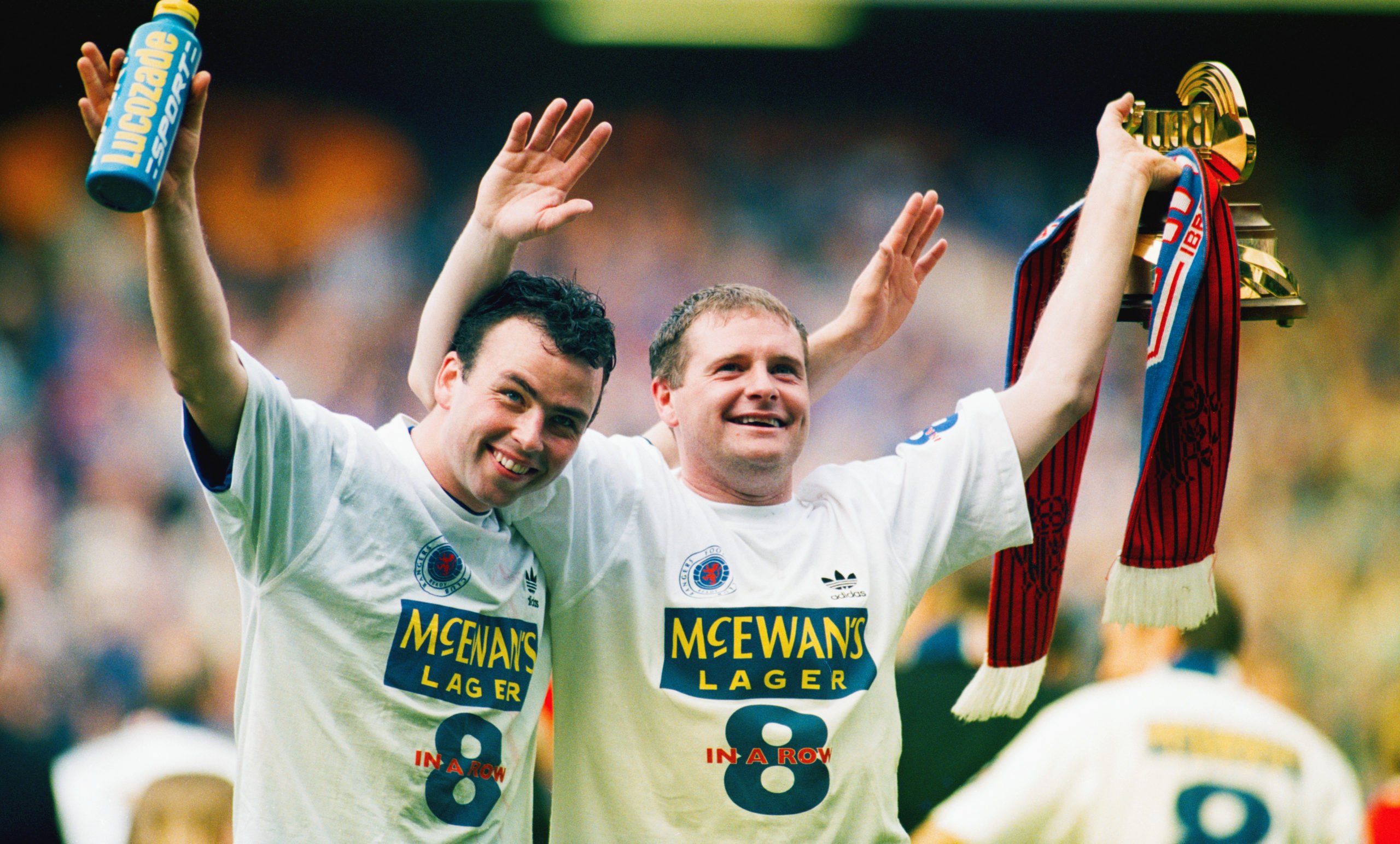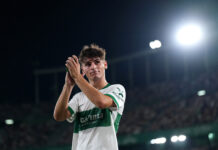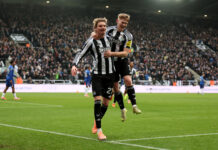1996. What a year that was. We went from the Spice Girls rocking the Britpop music scene to the Spice boys of Liverpool shocking the dress sense scene in the FA cup final in those White suits. Atlanta, Georgia, would host the Summer Olympics & the American hero that is Kurt Angle would win Gold in the Wrestling event.
In the UK, we would see the final year of a Conservative Government that had been in power since the 4th of May 1979. Dolly the sheep would become infamous as the world’s first cloned animal and born also the humorous broadside for our northeast friends in the Granit City. Oasis would play a legendary gig over two nights at Knebworth to 250,000 people as they cemented their status as the Indy band of the Britpop era. One Oasis song comes to mind that takes me back. Champagne Supernova. One particular line poses a rather magnificent question. “Where were you when we were getting high?” My answer is Ibrox Stadium on April 28th, 1996. I witnessed the greatness of Paul Gascoigne in the flesh.
It was a beautiful sunny April day. A title decider on Edminston Drive, although this wasn’t anywhere near the same magnitude of 1991, and the final day against our opponents of that day Aberdeen, who also stood between us and an 8th Scottish football title in a row. There was a mixture of nerves mixed with electricity charging the Ibrox air that day.
Our friends from the northeast had clearly not read the script as Brian Irvine had put them ahead to add to the enormity of the occasion. We needed something special. And we were about to witness a moment of history as an inspired Paul Gascoigne in his first season at Ibrox since signing from Lazio for £4.3m would score a hattrick to bring home the title and cement his place in Rangers history forevermore.
With time running out and the scores locked at one all, Gascoigne picked up the ball inside his own half and went on one final lung bursting crusade as he waltzed past every red shirt in his path before curling a left foot strike low into the bottom corner. His Verve & Energy beyond belief as Ibrox erupted into a crescendo of noise. The formality came from the penalty spot to seal the Hat-trick, match and Scottish Premiership title.
He would go on to sweep up the Players’ and Football writers’ player of the year before wrapping up the double in what many of us know as the “Laudrup Final”, a crushing 5-1 defeat of Hearts, ironically with a Gordon Durie hattrick. Not a bad first season at all, and we haven’t even scratched the surface of what was achieved. In short, Gazza’s first season was simply Supersonic as he reached new heights.
When I think about 1996, for me, it was THE year of Paul Gascoigne. For his aforementioned exploits for Rangers to brilliance at Euro 96 as he inspired England on home soil to come within an outstretched foot away from the final. Gascoigne was the man of the moment. From one of the greatest goals in final’s history against Scotland to a starring role as the Dutch were utterly humiliated at Wembley. It really felt like this was his moment.
Sadly, the efficiency of a German side still reeling from their weak surrender of the World Cup in the USA 2 years earlier would have other ideas. The Cruelty of penalty kicks once again stirring up old wounds from Italia 90 and the game that saw the nation fall in love with the then 23-year-old Tottenham Hotspur midfielder. For myself to fully understand how Gazza arrived at this point for both club and country, I had to go back to the beginning and unpeel this complex person layer by layer to get to know the person as well as the footballer.
Paul John Gascoigne. Named after 2 of the world’s greatest ever musicians, Paul McCartney & John Lennon of the Beatles. He already had a Superstar beginning to his life as his destiny would play out.
Born in Gateshead, in the Northeast of England. Situated on the south of the River Tyne in what was a traditional mining town. The industry dominated the northeast for decades until its decline in the 1980s, leaving behind mass unemployment and social deprivation. Gateshead is also twinned with a small town in France called Saint-Etienne Du Rouvray. A town whose namesake some of you might be familiar with due to a certain Bicycle in the Ibrox Trophy room. And legend has it that a certain Mr Gascoigne was more than familiar with this set of wheels.
Gascoigne was one of 3 children born to John and Carol. One key element as his life plays out is the unwavering love and kindness he had for his family.
At an early age, Paul was catching the eye of football scouts. Eventually, he would sign for his boyhood heroes Newcastle United in 1980. Gascoigne would captain the youth side to FA Cup glory, scoring twice in the final over Watford. Even from an early age, he was destined to go all the way to the top of the game. One of the main attractions was so he could financially provide for his family. A common theme as his career progressed.
Finally, at the age of 18 years old, Gazza made his debut for Newcastle United in the old English first division under the watchful eye of Leeds United and future Republic of Ireland legend Jack Charlton.
Gazza flourished at Newcastle as a dynamic attacking midfielder with an eye for goal. 25 goals in 104 appearances would earn him a British transfer record £2.2m move to Tottenham Hotspur when he famously turned down the advances of possibly the greatest manager in British football history, Sir Alex Ferguson and Manchester United. Sir Alex would famously go on to recall how Gazza was the one player he wished he had managed; high praise indeed from one of the game’s greatest.
At Tottenham, we were to see glimpses of the real Paul Gascoigne. Maybe a warning for what the future would hold as he came into his own as a man. As stated before, he was a family man first and foremost. This was evident when he spent almost his entire signing on fee from Tottenham on buying a house for his family. His generosity, even at an early stage, showing the size of heart easily matched the talent.
Sadly, as time would tell, others would notice this trait and circle accordingly when the time was right. His vulnerability was already being exposed before the watching world and, in particular, tabloid press, who as we will find out, would sink to despicable depths.
The American Pianist Oscar Levant once said, “There’s a fine line between genius and insanity. I have erased this line.”
There are some fine examples in football of mavericks with all the talent in the world yet the seemingly unquestionable desire to hit the self-destruct button at will. Sir Alex Ferguson would find this out at Manchester United with the enigmatic Eric Cantona, the brilliant Frenchman with the temper of a Red Devil. From FA Cup winning strikes to striking a supporter’s chest via a flying kick, he was an art form in his own right.
George Best was another with the Manchester United connection. Before my time, although luckily, I grew up with a father who waxed lyrical about one the greatest ever to play the game. Sadly, his demons were well documented as it’s a tragedy he never added to his 470 appearances for Manchester United. His fall from grace, a tragic shadow of the European cup winning icon.
Eerily, Paul Gascoigne was heading along the same path. Alcoholism was one demon that would conquer its fair share of footballers over the decades. Especially those who had found themselves instantly rich overnight. Our very own Jim Baxter would also fall into this category.
The most defining example of his ability to go from Superstar to Self-destruct was the FA Cup campaign of 1990/1991. From the highs of scoring a thunderbolt free kick in the 3-1 semi-final victory over George Graham’s champions in waiting, Arsenal, to the sheer low of being carried off on a stretcher with ruptured knee ligaments in what should have been the biggest spectacle of his career in the FA Cup final. A wild and reckless tackle ending his game after 15 minutes. Instead of being sugar Sweet, it was sour as his England teammate Stuart Pearce would score the resulting free kick, although Spurs would win on penalties. To this day, it remains the last time Spurs won the FA cup. 30 years ago.

Getty Images (https://www.gettyimages.de/)
Imago Images (https://www.imago-images.de/)
By now, at Tottenham Hotspur, Gascoigne was renowned for being the clown prince. Forever a childlike figure which stayed with him throughout this career. Gazza’s antics ranged from planting fish in the car of his future teammate Durie to forever acting up for any camera crews that would be in the vicinity.
One constant that did keep him on the ground for a while was having the right manager at the right time. Sir Bobby Robson was the man who gave Gazza his debut for England.
Robson also hailed from the northeast, a small village named Sacriston which was only 12 miles from Gateshead. Robson was one of the game’s most respected individuals. A playing career spanning almost 600 games and now one of the best managers in Europe. He was making his managerial name at Ipswich Town, where he would win the UEFA Cup as well as the FA Cup during his tenure. Robson would go on to have success all over Europe. Most notably with PSV Eindhoven, Porto & FC Barcelona. Robson would be the man who signed Ronaldo for Barcelona as well as having a key role in the managerial careers of Jose Mourinho and Andre Villas-Boas. Both men credit him as having a massive influence.
With England, Gazza had an astute tactician who would enhance his game; however, more importantly, he had a father figure. Someone who knew how to handle his nature and get the best out of this once in a generational talent.
Robson gave Paul the platform to perform at Italia 90 that would see England reach the semi-final only to be thwarted by arch-rivals Germany. A yellow card against the Germans ruling him out of a possible final caused the tears to flow and resulting in capturing the heart of a nation. Paul Gascoigne was indeed announced as the BBC Sports Personality of the year for 1990. At the club level, Gazza also at this time had the calming influence of Terry Venables, who would also go on to manage him with England in 1996. He simply flourished under the right leadership and guidance.
Gascoigne missed the entire 1991/92 campaign due to the injury sustained in the FA cup final, and there were doubts if he would ever play the game again, let alone be the same player. This meant that he missed the 1992 European Championships in Sweden that summer under the new England manager Graeme Taylor. In essence, over the next two years at the international level, he failed to reach the same heights as he was overlooked.
England would fail to qualify for the World Cup in the USA of 1994, which would seal the fate of Graeme Taylor, who was famously ridiculed as a Turnip in a tabloid press that would soon turn its eyes on the once golden boy of the English game. A sequence of events that in my mind would have a direct bearing on his decision to join Rangers just a few short years later. And I will explain why shortly.
In the summer of 1992, Gazza made the switch to Lazio for £5.5m. A bold move after such a severe injury to enter the colosseum of Rome. As we had seen, he never shirked a challenge, and this was no different. Lazio finished in 10th place the season before, and big things were expected of their new arrival. They had some star names such as Giuseppe Signori, World cup winner Karl-Heinz Riedle, Thomas Doll & Arron Winter.
Under Dino Zoff, it was a mixed stay in Rome. A last minute equaliser against Roma would make anyone a hero in the eyes of the Biancoceleste, even if not the eye of the manager. In 1994, a combination of a new manager and a broken leg would end another season through injury. This would lead to an inevitable parting of ways at the end of the season. However, nobody could have predicted what was to come over the coming weeks as new manager Zdenek Zeman had decided he was surplus to requirements at the Stadio Olimpico. His time in Italy was at an end.
And so, it came to be. On July 10th, 1995, arguably one of the greatest signings in Scottish football history came to be. A scorching hot day in Glasgow saw swathes of people flock to Ibrox to welcome the England icon to Ibrox. The Bleach Blonde haircut would inspire school kids the length of the country to attain the same look. It would go down as one of The iconic styles of the 90s.
Life in Rome could not have prepared anyone for the Goldfish bowl of Glasgow. In my own humble opinion, there are few derbies in the world that can match the intensity on and off the park that Rangers and Celtic provide. A nuclear fusion of passion when these teams collide, with the spark in the stands fuelling the atmosphere we have come to love. We were about to find out if we were going to see the roar of a Lion or the surrender of a pussy cat. Many a talented and gifted player has arrived in our quirky and physical Scottish league and simply could not get a hold of the game up here. We are talking about World Cup winners such as Stephane Guivarc’h, our very own Catastrophe Apostrophe or European cup winners such as Peter Van Vossen. It’s a league like no other.
If ever there was a manager who was the ultimate father figure, it would certainly be Walter Smith. Knowledge of the game second to none in the Scottish game, but also a highly respected figure as a man.
This was the biggest signing Rangers had made since the day Graeme Souness walked through the doors at Ibrox. Make no mistake, David Murray sought his own Galactico, and this signing ticked every single box. It was possibly the last time that Rangers, in my opinion, were able to compete with the top of the English Premier League.

Getty Images (https://www.gettyimages.de/)
Imago Images (https://www.imago-images.de/)
If Paul Gascoigne were in today’s era, the only way we would see him at Ibrox would be a testimonial or to see out his career. The Gascoigne/Laudrup combination would go down as one of the greatest in Rangers history as they dominated the game in the quest for the holy grail of 9 in a row. Will we ever see players of that esteem again at Ibrox? The jury is out. TV money has changed the landscape.
Gazza was about to find out very quickly about the Scottish culture, and also, it would be the first test of Walter Smith’s patience with the flawed genius and his stay at Ibrox. Rangers would entertain Steaua Bucharest on 29th July 1995. Gascoigne would score in a routine 4-0 win in the Ibrox international tournament. However, his celebration would make the headlines for all the wrong reasons. He imitated the playing of a flute, and in the heat of secular Scottish society, anything inflammatory on the religious divide wasn’t the smartest thing to do, even for the clown prince. A very steep learning curve on life in Scotland’s west coast indeed.
Gascoigne wasted no time in making friends with the media. With newspaper columnist & Scotsport pundit, Gerry McNee often referring to Gazza only as Number 8, for such was his intense disdain for him. McNee, in particular, once alleged how Gascoigne kicked a ball at him in the press box at Easter Road. Gazza also found out some referees also had their sense of humour bypassed on the field. In particular, Dougie Smith. The Whistler dropped his yellow card only for Gascoigne to find it and jokingly yellow card the ref. Smith was incensed and subsequently booked him for dissent. A first for a Scottish football official uniting the entire country in agreement at the staggering arrogance on display.
As discussed, this season was to be one the finest of Gascoigne’s career. A first league goal coming at Parkhead as Rangers lay down an early marker with a 2-0 victory in the first Old Firm game of the season. It would be the only derby victory in the league that season, with the remaining three games all being draws.
Gascoigne would go on to score vital winners against Aberdeen amongst others before claiming the hat trick that set his name into history. He also managed the ugly side of the game too. One particular match of note being against Partick Thistle at Firhill. A double securing a 2-1 win in a game where his opposite number Billy McDonald simply lost his cool. Gascoigne was simply unplayable as the red mist descended, and a deserved red card followed.
The following season Rangers secured the one title that they craved. Gascoigne was pivotal with 17 goals in 34 matches, including two more hattricks, and two goals in a thrilling League Cup final win over Hearts. A memorable diving header on the counterattack at Ibrox against Celtic capped off another fine goal.
However, off the field, the cracks were beginning to appear. High profile tabloid incidents, including escapades of Cigarettes & Alcohol with Celebrity friends Chris Evans & Danny Baker were just for starters. His close friend and ally Jimmy “5 Bellies” Gardner was always on hand. There were also well publicised incidents surrounding his personal life that was unsavoury, to say the least. The self-destruct button wasn’t just hit; it was obliterated. Outside influences were now affecting his career.
By 1997/98, the Rangers & Paul Gascoigne love affair was about to come to an abrupt halt. Crashing out of Europe twice to IFK Goteborg & Strasbourg respectively was the first sign of trouble. As the nineties were beginning to slide away and become a bit of a Blur, so did the wheels of what had promised to be the 10 in a row season. Fitness worries, off-field issues and behaviour were enough to now test the patience of Walter Smith. The one man who had brought out the best of this mercurial genius.
You could excuse the ignorance once of the Flute playing incident, especially if not a native to the political and religious landscape of the west of Scotland. However, after three years, you could not excuse the same actions at the home of our rivals. The resulting fine and SFA ban may well have been what tipped Walter over the edge.
This Lucky Man had simply gone too far this time, and in March 1998, his Rangers career was over after being sold to Middlesbrough. A sad end to his time at Rangers that would also culminate in famously being axed from the England World cup squad by Glenn Hoddle for the tournament in France. Gascoigne had been a regular in Hoddle’s England side, including a sensational performance in his old stomping ground of the Stadio Olimpico as England held Italy to a goalless draw to pip them to qualify for the World Cup in France the following summer. Paul Ince sporting a blood-soaked headband strikingly similar to the historic images of Terry Butcher were now just as iconic.
Gazza was shellshocked at his omission. Some might say it was a snub that he never really recovered from as his career petered out.
For me, there were a few key factors at play in Paul Gascoigne’s arrival at Rangers. If he hadn’t lost almost two years of injury, I believe England wouldn’t have missed out on the 1994 World Cup, where his stock would only have risen and maybe priced us out of a move. His relationship with Graeme Taylor was another factor at play. He was integral to that England side, and pre-injury was among the very best in the world. Missing 21 England games was massive.
Paul Gascoigne’s personal life for the next two decades has been well documented. Some of the levels the tabloid press would stoop to for a scoop were quite frankly disgusting. Leaving bottles of spirits at the door of an alcoholic just to get the photographs of the chaos after is quite frankly another reason mainstream media is dying. Add on the vultures who took advantage of him; it’s little wonder how things turned out for a period. Maybe a sense of justice when he was awarded substantial damages over the infamous phone-hacking scandal that rocked UK journalism.
It wouldn’t sit right with me to entirely ignore his past indiscretions, nor can I condone such behaviour, especially towards his then wife. Personally, to close this chapter, I would like to focus on the fact he is right now in good health than his past misdemeanours. As I type, he appears to be on the right path, attending events and sharing stories of the life we all remember him for. Hopefully, he can find redemption in his own mind, at the very least.
Paul Gascoigne was a remarkable talent. A true one off and one of the greatest to grace the beautiful game. He is rightfully remembered on the field for his explosive talents, exquisite craftmanship and entertainer he was. His record at Rangers was 39 goals in 104 matches. A ratio of a goal every 2.67 games. A remarkable feat for a midfielder, and very few Rangers players of the topflight era of Souness until now has a better record. Personally, it was an absolute privilege to watch him in his prime, especially on that sunny day of April 1996 as we clinched number 8.
25 years ago, a new chapter was well and truly written in the illustrious 150-year history of our sacred institution. Hopefully, one day we will witness other icons pull on the famous Blue jersey, and if they can be even half as successful as Paul Gascoigne was, then we are in for a treat indeed.
As always, stay humble, stay safe and remember we well and truly are the people.
Editorial Note: Did you know this article was published first on our exclusive Patreon page? If you love Scottish football while sick and tired of the same old biased MSM coverage, this is for you. The 4th Official needs your support. Due to the unprecedented situation as a result of the COVID 19 pandemic, the digital media space has been completely devastated. There has been a massive shortfall in revenue (even while viewership is up) as we scramble how to make sure that we go on with our daily job. We are proud to put up exclusive stuff on Scottish football as well as an early release of our podcast interviews with relevant personalities of the game (recent guests have been David Martindale, Matt Polster, Greg Docherty, Daniel Stendel & a lot more) on our Patreon account and hope you would support us in these tough times. We have supporters from atleast 11 countries, and you can be too by chipping in just £2.99/month (or become an annual supporter). Become a proud Patron of The 4th Official!


 ADD AS PREFERRED SOURCE ON GOOGLE
ADD AS PREFERRED SOURCE ON GOOGLE


